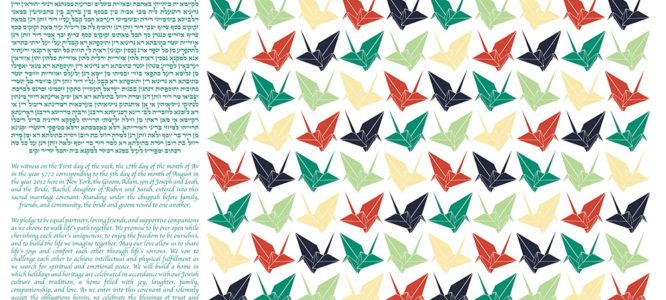Longevity and Prosperity: Origami Ketubah
Origami is a paper-folding art originating from Japan. Origami may seem like a purely aesthetic hobby, while in reality there is a lot of history and unique symbolism to it. While origami may have started as an activity that only the privileged could afford, it certainly evolved into a cultural, ceremonial, religious, and artistic notion that truly represents one of the main symbols of Japan. The meaning of the word origami is pretty straight-forward and self-explanatory, as it derives from Japanese words ori, meaning folding, and kami, meaning paper. So, what does origami really stand for today, and what were its symbolic meanings throughout history? Let’s find out.
As we said, origami is an art initiated in Japan, where the paper was brought from China in the sixth century and represented luxury at the time. Given that paper couldn’t be obtained by many, origami wasn’t an art that was widely popular right away. Instead, it was used for ceremonial and religious reasons. Later on, as paper became more attainable, the popularity of origami as a form of art grew, as well. In 1797, very first written instructions for origami folding appeared, which marked the beginning of origami popularization.
When it comes to origami motives, the most common shapes seem to be birds, flowers, and overall nature-inspired symbolism. While back in the day origami artists used to cut the sheets of paper to create the desired shape, today we can see an entirely different technique with a touch of European inspiration, where the paper is folded rather than cut.
While on the topic of origami shapes, it seems that a crane is the most commonly created origami piece. If you’re not quite familiar with the notion of crane, it is enough to say that a crane is a mystical creature that was believed to have a lifespan of a thousand years. The legend has it that the person who successfully created a thousand origami cranes would indeed live a thousand years. Therefore, origami figures, including those representing cranes, usually stand for longevity, hope, and health.
The Origami ketubah design is a true representative of how two cultures that we may perceive as diametrically different can blend into each other perfectly. The crane origami symbol dominates throughout the design, complementing the traditional ketubah text on the left. On top of it all, this origami ketubah design features a unique, bold modern art design that you’re used to seeing in all of our ketubah designs. For more origami ketubah pieces, make sure to check out our online gallery!






